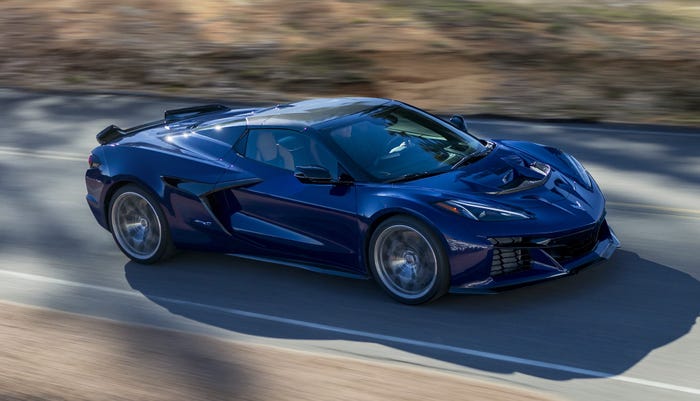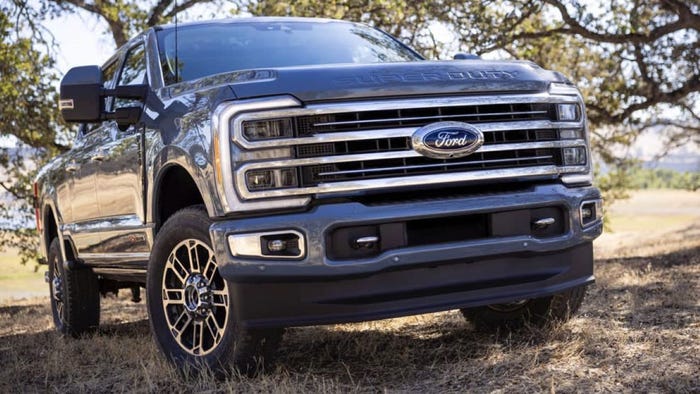Ward’s Names 10 Best Engines Winners
This year’s list represents the biggest turnover in the competition’s history, with four completely new engines, two EV propulsion systems, two heavily modified engines and only two carryover powerplants.


The auto industry is embracing the age of electrification, and so too is the Ward’s 10 Best Engines list.
Both the Nissan Leaf electric vehicle and Chevrolet Volt extended-range EV earn their way onto the 2011 list, as selected by Ward’s editors after evaluating 38 vehicles with new or significantly improved engines for the ’11 model year.
But fuel efficiency and environmental friendliness are not the most important criteria for eligibility this year, as seen by recognition of the new 5.0L V-8 in the Ford Mustang GT, 5.0L V-8 in the Hyundai Genesis and the 3.0L supercharged V-6 in the Audi S4.
“We have something for everybody on this year’s Ward’s 10 Best Engines list,” says Drew Winter, editor-in-chief of Ward’s AutoWorld magazine. “It’s the most diverse mix we’ve ever had, as well as the most technologically advanced.”
This year’s winners and the applications tested:
3.0L TFSI Supercharged DOHC V-6 (Audi S4)
3.0L N55 Turbocharged DOHC I-6 (BMW 335i)
1.6L Turbocharged DOHC I-4 (Mini Cooper S)
3.6L Pentastar DOHC V-6 (Dodge Avenger)
5.0L DOHC V-8 (Ford Mustang GT)
1.4L DOHC I-4/111kW Drive Motor (Chevrolet Volt)
5.0L Tau DOHC V-8 (Hyundai Genesis)
80kW AC Synchronous Electric Motor (Nissan Leaf)
2.0L DOHC I-4 Turbodiesel (Volkswagen Jetta TDI)
3.0L Turbocharged DOHC I-6 (Volvo S60)
Now in its 17th year, the Ward’s 10 Best Engines competition is designed to recognize powertrains that set new benchmarks in their respective vehicle segments.

Banquet room fills up for 2010 Ward’s 10 Best Engines ceremony last January.
“The one thing they have in common is they all are stand-out performers in their own way and sell the value proposition of the vehicles they power,” Winter says.
Ward’s editors spent October and November driving the vehicles in their routine daily commutes around metro Detroit and scored each engine based on power, technology, observed fuel economy and noise, vibration harshness. There was no instrumented testing.
This year’s list represents the biggest turnover in the history of the competition, with six completely new engines or propulsion systems, two heavily modified engines (from BMW AG and Hyundai Motor Co. Ltd.) and only two direct carryover engines (from Volkswagen AG and Audi AG) from the 2010 list.
The Audi S4 supercharged V-6 muscles its way onto the list for a second straight year with a stealthy 333 hp and 325 lb.-ft. (440 Nm) of torque that peaks at 2,900 rpm and holds steady until 5,300 rpm. The effect is all-consuming, washing over the driver like waves on a beach.
Through it all, the TFSI V-6 manages better than 25 mpg (9.4 L/100 km) on the highway during Ward’s evaluation. Having replaced a gas-guzzling 4.2L V-8, the forced-induction V-6 demonstrates how engine downsizing need not come with a performance penalty.
BMW’s well-regarded 3.0L N54 twin-turbocharged inline-6 earned Ward’s 10 Best Engines honors in 2007, 2008 and 2009. For 2011, the N55 I-6 in the 335i replaces the two compressors with a single twin-scroll turbocharger that saves weight, improves throttle response, boosts fuel efficiency (15% over the N54) and reduces friction, while decimating the notion of turbo lag.
Integrating the third-generation Valvetronic intake and Double-VANOS stepless variable valve timing, the 300-hp “Twin Power” N55 reaches its torque apex of 300 lb.-ft. (407 Nm) at a mere 1,200 rpm, propelling the 335i sedan with shocking ease. For drivability and smoothness, the N55 is unparalleled.
Another new engine on this year’s list is the 1.6L turbocharged direct-injection I-4 that packs a mighty punch in the Mini Cooper S. With a specific output of 113 hp/L, this package quickly rose to the top of a crowded field of new small-displacement 4-cyl. engines in this year’s competition.
The latest “Prince” engine in the Cooper S is assembled for BMW by PSA Peugeot Citroen in Douvrin, France, and integrates BMW’s excellent Valvetronic fully variable valve timing system, which enhances power and fuel efficiency. Driven hard, this prince of an engine still musters better than 34 mpg (6.9 L/100 km) during our test drive.
Freshly launched from Chrysler Group LLC’s Trenton, MI, and Saltillo, Mexico, engine plants, the all-new 3.6L Pentastar V-6 arrives with extremely high expectations, powering 10 model-year ’11 applications ranging from sedans to SUVs.

Editor-in-Chief Drew Winter addresses crowd at 2010 Ward’s 10 Best Engines banquet.
Ward’s editors drove the Dodge Avenger and Jeep Grand Cherokee for 10 Best Engines and found the Pentastar up for any challenge. Even without direct injection and turbocharging, the V-6 does not seem to lack sophistication. At idle, it is as quiet as a whisper. After driving the Avenger, one editor said it’s difficult to believe an engine this good is in such an affordable car.
The Ford Mustang has a long history with V-8s, but pony-car aficionados formed a special bond with the 5.0L V-8 that launched in 1979. For ’11, the all-aluminum “Five-Oh” returns, dazzling potential buyers with 412 hp and advanced twin independent variable camshaft timing, which boosts low-end torque, peak power and fuel economy.
Of course, few 5.0L buyers are shopping MPG. For those who are, one Ward’s editor exceeded 19 mpg (12.3 L/100 km) in mostly highway driving. This engine might be politically incorrect by today’s standards, but there is a place for it in the market. Embrace your inner muscle car and enjoy this burly V-8 as long as the Environmental Protection Agency deems it street legal.
Like Chrysler, General Motors Co. was pulling itself out of bankruptcy little more than a year ago. Meanwhile, it was developing a car that revolutionizes mobility: the Chevrolet Volt. Some consider it a glorified hybrid while others just don’t understand it.
Here are the facts: It plugs into a 120V wall socket and charges in 10 hours, or four hours on a dedicated 240V charger. Depending on several factors, the range will last anywhere from 25 to 40 miles (40 to 64 km), at which point an 84-hp 1.4L 4-cyl. engine imperceptibly kicks on to spin a generator that continues turning the wheels.
The EPA rates the Volt’s overall combined fuel efficiency at 60 mpg (3.9 L/100 km); in electric mode, the rating is 93 mpg equivalent (2.5 L/100 km). Drive the Volt almost exclusively in electric mode and gas stations will become less a part of daily life. The “Voltec” propulsion system is brilliant – a technological masterpiece.
Returning to the Ward’s 10 Best Engines list is Hyundai’s excellent Tau V-8. In 2009, when Hyundai’s first-ever V-8 won a Ward’s 10 Best Engines award, it displaced 4.6L, employed conventional port injection and produced 375 hp. In 2010, it was tweaked to generate 385 hp.
For ’11, the Tau returns practically as a clean-sheet design, with more displacement (5.0L), direct injection and staggering output (429 hp and 376 lb.-ft. [510 Nm] of torque) for the Genesis and Equus flagship sedan.
Meanwhile, fuel efficiency is rated higher with the new Tau than the current 4.6L. During our drives of the 5.0L, Ward’s editors achieved 19 mpg (12.3 L/100 km). It’s enough savvy thrust for this scrappy South Korean upstart to command respect among the world’s best luxury brands.
Nissan Motor Co. Ltd. manages the first-ever Ward’s 10 Best Engines award for an all-electric vehicle, the Leaf. True, the Leaf has no engine – just a battery-powered electric motor that turns the wheels through a single speed reducer.
What’s remarkable about the Leaf is how much it feels like a conventional car, with four doors, five seats and accelerator and brake pedals that could have been borrowed from a Nissan Versa, or any other gas-driven subcompact. The Leaf is affordable – about $25,000 with a federal tax credit – and a thrill to drive.
Range anxiety is a hurdle, just like in 1908, when the first Ford Model T buyers worried about finding gas stations. But an electrical socket – ubiquitous in the developed world – is all that is needed for people who want to own and drive a Leaf, while consuming no gasoline and creating zero emissions. As a propulsion system, it truly deserves recognition.
The Volkswagen Jetta TDI, with its 2.0L 140-hp turbodiesel, becomes the dean of the Ward’s 10 Best Engines list, the only returning winner with three consecutive wins at the same output levels with the same technologies onboard.
This quiet, pleasurable, torque-rich 4-cyl. demonstrates the finest attributes of the new generation of clean diesels, using regenerating particulate filters and oxidation catalysts to meet federal emissions standards.
The 2.0L engine’s small footprint lets it function without expensive urea-injection aftertreatment. There is no better vehicle for a roadtrip than the Jetta TDI, capable of 42 mpg (5.6 L/100 km).
Last but not least, Volvo Car Corp. lands its first Ward’s 10 Best Engines honor, for the 3.0L turbocharged I-6 in the S60 sedan. Volvo clearly benchmarked BMW in developing the supremely smooth “T6” engine, based on its delicious mid-range power band and paucity of turbo lag.
This engine is perfectly suited for the all-new S60 and powers it into contention against bigger, better-established luxury entries. The T6 creates a new performance-oriented dimension for a brand seeking to expand under new Chinese ownership.
To be eligible for the competition, each engine must be available in a regular-production U.S.-specification model on sale no later than first-quarter 2011, in a vehicle priced no more than $55,000, a price cap indexed to the average cost of a new vehicle.
Winners from the 2010 competition automatically were eligible and evaluated against the new engines.
The awards will be presented at a Jan. 12 ceremony in Detroit during the North American International Auto Show.
Complete stories about the Ward’s 10 Best Engines will be featured Dec. 16 on WardsAuto.com and in upcoming issues of Ward’s AutoWorld magazine and Ward’s Engine & Vehicle Technology Update newsletter.
About the Author(s)
You May Also Like


_(2).jpg?width=700&auto=webp&quality=80&disable=upscale)


